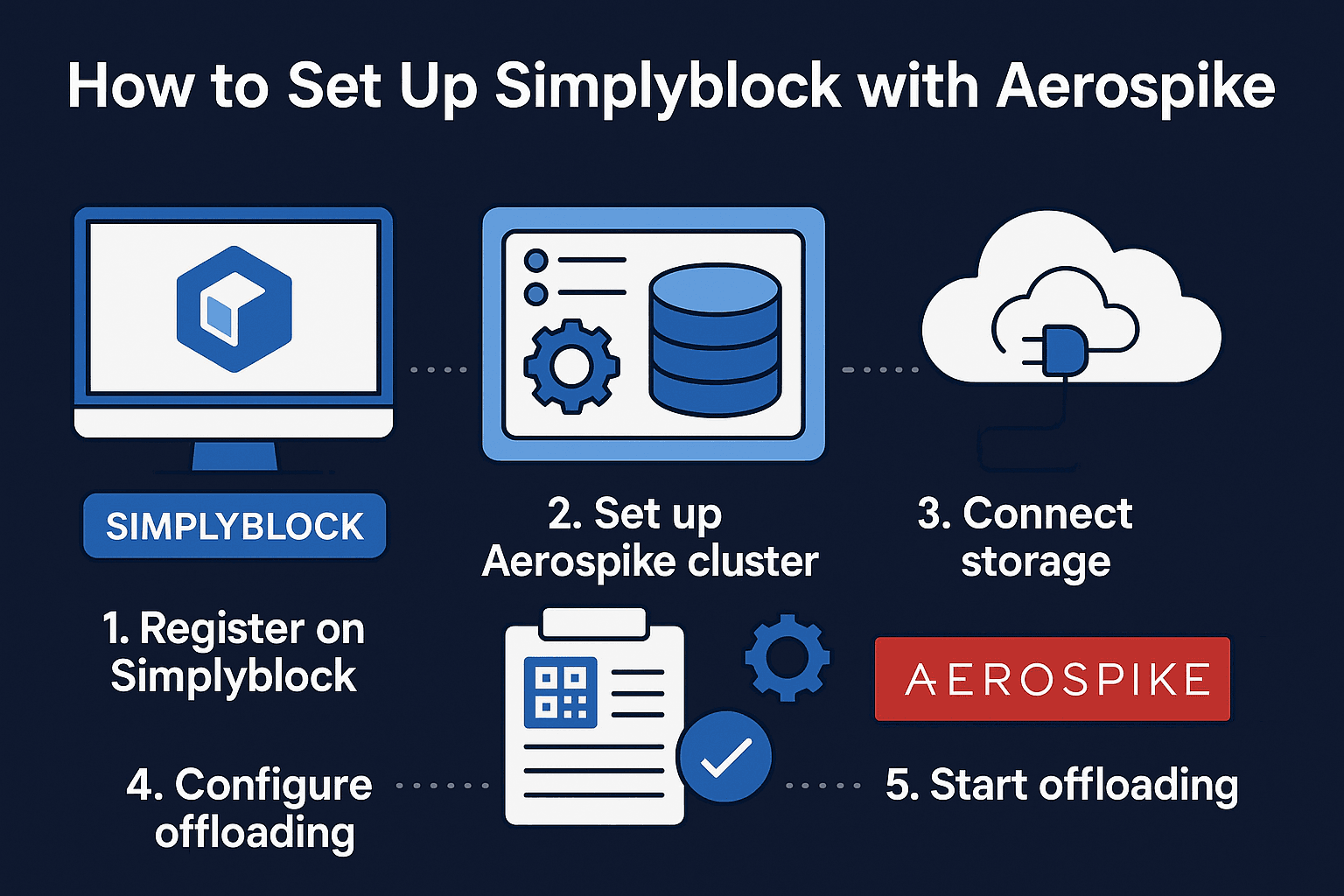Using Aerospike as your NoSQL database requires a reliable and high-performance storage solution to ensure fast, scalable, and efficient data management.
Simplyblock offers low-latency, high-throughput storage that complements Aerospike, enhancing your database’s speed and scalability. Follow these steps to set up simplyblock with Aerospike, from installation to performance optimization, and maximize your database’s potential.
Why Integrate Simplyblock with Aerospike?
Integrating simplyblock with Aerospike offers several key benefits that enhance both performance and scalability. Aerospike, a fast and scalable NoSQL database, is complemented by simplyblock’s high-speed, low-latency storage, ensuring optimized performance by handling high-throughput data without delays.
Simplyblock’s storage is also easily scalable, allowing you to expand your system’s capacity as needed, without impacting performance. Additionally, simplyblock provides redundancy features that protect your data during hardware failures, ensuring that Aerospike maintains its high availability and reliability at all times.
🚀 Protect Aerospike with Multi-AZ Resilience
Use simplyblock to ensure high availability and fast recovery across availability zones.
👉 Use simplyblock for Multi-AZ Disaster Recovery →
Step 1: Install Simplyblock and Aerospike
Before you can integrate simplyblock with Aerospike, you need to install both platforms on your system.
Installing simplyblock
- Download simplyblock: Get the latest version from simplyblock’s documentation.
- Install simplyblock: Follow the installation instructions in the simplyblock documentation.
Installing Aerospike
- Download Aerospike: Visit the Aerospike download page.
- Install Aerospike: Follow the Aerospike installation guide.
Verify installation:
aerospike status
Once both simplyblock and Aerospike are installed, you’re ready to proceed with integration.
Step 2: Set Up Simplyblock Volumes for Aerospike
Now, you need to create and attach a simplyblock volume to your system, which Aerospike will use for data storage.
Create the simplyblock volume:
sbctl volume add <VOLUME_NAME> <SIZE> <POOL_NAME>
Attach the volume to the system:
sbctl volume connect <VOLUME_NAME>
# Use the resulting connection string and execute it on the client machine.
Verify the volume is attached:
lsblk

Step 3: Configure Aerospike to Use Simplyblock Storage
Next, configure Aerospike to use the simplyblock storage volume.
Edit the Aerospike configuration file (/etc/aerospike/aerospike.conf):
In the namespace section, configure the storage engine to point to the simplyblock volume:
namespace test {
path /mnt/aerospike
storage-engine device {
device /dev/nvme0n1
write-block-size 128K
}
}
Restart Aerospike to apply the configuration changes:
sudo service aerospike restart
At this point, Aerospike is now configured to use simplyblock for its storage needs.
Step 4: Verify the Integration
To ensure that everything is working as expected, verify the integration of simplyblock with Aerospike.
Check the status of Aerospike:
aerospike status
This confirms that Aerospike is running and using the simplyblock volume.
Ensure that /dev/sdb is the simplyblock device. This confirms that the volume is properly attached and available for use.
Step 5: Troubleshooting Common Issues
If you encounter any issues during the integration process, here are a few common problems and their solutions:
Volume not recognized by Aerospike: Make sure the simplyblock volume is properly formatted and mounted. Use lsblk to verify the volume is correctly attached.
Aerospike failing to start: Check the Aerospike logs for configuration errors. Ensure that the file paths in the Aerospike configuration file are correct.
Step 6: Performance Optimization for Simplyblock + Aerospike
To get the most out of your Simplyblock + Aerospike integration, it’s important to implement a few performance optimization strategies. First, ensure that you’re using SSDs for storage. Simplyblock works best with SSDs, as they reduce latency and maximize throughput, making the system more efficient for real-time data handling.
Second, it’s crucial to monitor system performance regularly. Use tools like iostat and Aerospike’s built-in monitoring tools to track disk I/O and identify any performance bottlenecks. Finally, optimize Aerospike settings by adjusting parameters like write-block-size and read-block-size in the Aerospike configuration file. Aligning these settings with your specific workload can improve throughput and overall performance.
Ongoing Management for Simplyblock + Aerospike Integration
Maintaining the performance of your simplyblock + Aerospike setup requires regular management. Start by monitoring disk usage to ensure that your system has sufficient capacity as your database grows.
Over time, you may need to optimize storage configurations based on workload changes or performance analysis to ensure continued efficiency. Additionally, it’s critical to backup configuration files and volumes regularly to safeguard your data during system maintenance or scaling operations. By following these practices, you can ensure that your system remains fast, reliable, and scalable over time.
Questions and Answers
Aerospike is optimized for high-performance, low-latency workloads, making it an ideal match for NVMe-based storage. NVMe significantly reduces latency and boosts IOPS, enabling Aerospike to handle real-time data processing more efficiently, particularly in high-throughput environments such as ad tech or financial services.
Simplyblock boosts Aerospike performance by leveraging NVMe over TCP storage, offering faster IOPS and lower latency compared to traditional storage. This results in more responsive and scalable Aerospike deployments, especially for write-heavy or low-latency applications.
Yes, you can deploy Aerospike in Kubernetes using persistent NVMe volumes. Simplyblock provides a CSI driver that enables dynamic provisioning of high-speed NVMe storage, fully compatible with Kubernetes workloads and optimized for stateful sets like Aerospike clusters.
The best storage for Aerospike on Kubernetes is NVMe-based block storage due to its low latency and high throughput. Simplyblock’s NVMe-TCP integration for Kubernetes offers the ideal balance of performance, scalability, and ease of integration with containerized workloads.
To configure Aerospike with simplyblock, define a StorageClass using the Simplyblock CSI driver, then reference it in your persistent volume claims. This setup automatically provisions encrypted, high-performance NVMe volumes that integrate seamlessly with Aerospike pods in Kubernetes.

